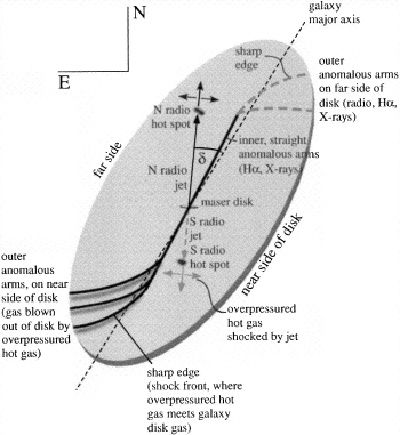
M106 has the distinction of harboring the nearest extragalactic astrophysical jet. The proximity of M106 and its incline of about 72 degrees expose the central region of the galaxy's barred core to earthbound telescopes giving astronomers the opportunity to learn about "jet" phenomenon in great detail. Jets are highly collimated beams of matter and energy associated with the cores of active galaxies. They are best observed at radio wavelengths and usually come in pairs aimed in opposite directions. M106 is a type of active galaxy classified as a seyfert galaxy by virtue of its active nucleus and characteristic emission spectra. Like other seyfert galaxies it shows evidence of a massive black hole (about 36 million solar masses) within its nucleus. Surrounding the black hole is a disk of spiraling matter called an accretion disk. The physics of the accretion disk is such that material falling into the black hole releases copious amounts of energy sometimes in the form of powerful jets. The two sided radiojet of M106 exits the core traveling in opposite directions and extends through the galactic disk for about 16,000 light years before it deflects into the halo of the galaxy. The drop off in density within the galactic halo forces the jet to "break out" into many filamentary components once outside the disk. Also peculiar to M106 is the presence of several "anomalous arms" which protrude out from the center. The arms are visible in different wavelengths including the optical. The prevailing theory is that the anomalous arms represent excited columns of superheated gas tracing previous trajectories of the astrophysical jet as the jet has undergone a large amount of precession in the past.
M106 also contains an exotic object called a water vapor maser associated with its circumnuclear accretion disk . The maser generates monochrome energy (microwave) by a process similar to its optical counterpart, the laser. Because of its predictable eccentric orbit, masers allow very precise estimates of distance to galaxies which contain them.

Chart coutesy of:
Chandra Observations and the Nature of the Anomalous Arms
of NGC 4258 (M106) A. S. Wilson 1 and Y. Yang
Astronomy Department, University of Maryland, College Park, MD
20742; wilson@astro.umd.edu, yyang@astro.umd.edu
and G. Cecil , Department of Physics and Astronomy, University
of North Carolina, CB 3255, Chapel Hill, NC 27599-3255; cecil@physics.unc.edu